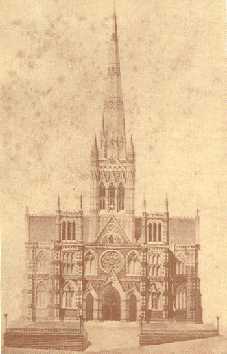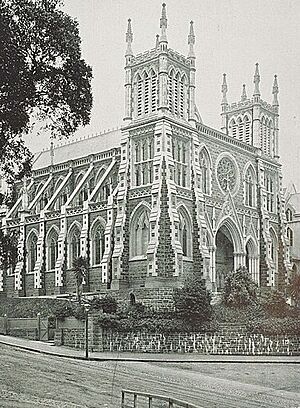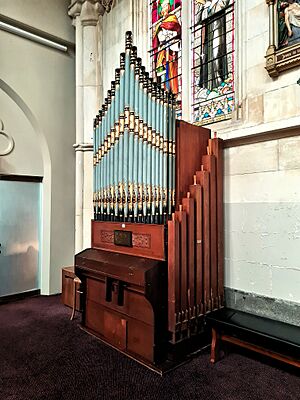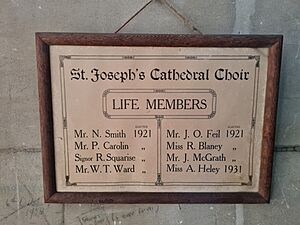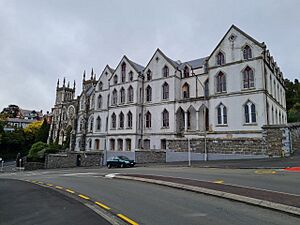St Joseph's Cathedral, Dunedin facts for kids
Quick facts for kids St Joseph's Cathedral |
|
|---|---|
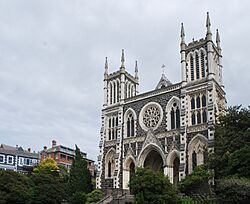
St Joseph's Cathedral as it appeared in 2011
|
|
| 45°52′28″S 170°29′53″E / 45.87444°S 170.49806°E | |
| Location | City Rise, Dunedin |
| Country | New Zealand |
| Denomination | Roman Catholic |
| Architecture | |
| Functional status | Open |
| Designated | 14 February 1886 |
| Architect(s) | Francis Petre |
| Architectural type | Cathedral |
| Style | Gothic Revival |
| Administration | |
| Archdiocese | Wellington |
| Diocese | Dunedin |
St Joseph's Cathedral is a very important church in Dunedin, New Zealand. It's the main church for the Catholic community in the area. It's where the bishop of Dunedin has his official seat. This special church area, called a diocese, was created on November 26, 1869. The cathedral is located in the City Rise area of Dunedin.
Contents
The History of St Joseph's Cathedral
The cathedral was designed by a famous architect named Francis Petre. He was known for designing many beautiful churches in New Zealand. St Joseph's Cathedral is built in the Gothic Revival style. This style looks like the grand churches built in Europe many centuries ago.
Before this cathedral, the first St Joseph's Church was built in 1862. It was a simple brick building and was the very first Roman Catholic church in Dunedin.
Building the Cathedral
The land for the cathedral was bought in September 1868. Building the cathedral was a bit tricky because the site had a gully and underground streams. Workers had to fill the gully with dirt and rocks.
To make sure the building was strong, they sank 40 large wooden piles deep into the ground. These piles were then connected with concrete arches. This created a very solid base for the cathedral. Even with these strong foundations, the front of the cathedral started to sink a little after about 15 years.
The foundation stone was officially laid and blessed on January 26, 1879. The first church service was held in the new cathedral on February 14, 1886. The main part of the building was finished in May 1886. It cost about £22,500, which was a lot of money back then! The original plan was for an even bigger building with a very tall spire, but that part was never completed.
Cathedral Updates and Restorations
Over the years, the inside of the cathedral has been changed several times. One big change was moving the main altar after a church meeting called Vatican II. It was later brought back. An older altar, designed by Petre, was taken apart in the 1970s. Parts of it are now used for a special cabinet called a tabernacle.
In the 1950s, the stone decorations on top of the two towers had to be removed because they were getting old and damaged. New concrete copies of these decorations were put back in place in 1975.
Bringing Back Heritage Features
Recently, in March 2023, the special rooms for confession were fixed up and put back to their original use. A shrine dedicated to Our Lady of Perpetual Succour was also brought back.
On November 19, 2023, the Blessed Sacrament was returned to the main altar's tabernacle. This was a special event for the church community.
Two beautiful angel statues, which used to stand by the main altar, were also restored. They were put back in their original spots. Their wings and the candle holders they once held had to be remade. The wings were put back on the angels in December 2023.
There are also plans to bring back the original altar rails, a wooden canopy over the altar, and a large crucifix to the main area of the church.
Special Architectural Features
The Baptismal Font
The baptismal font is as old as the cathedral itself. It is made from a type of stone called Oamaru limestone. The inside of the bowl is lined with shiny quartz pebbles from Moeraki Beach. This beach is famous because it's where Bishop Pompallier first landed in the south of New Zealand in 1840. He performed the first baptisms in the region there. The font was designed by Francis Petre, and its beautiful carvings were done by Louis John Godfrey.
Stations of the Cross
The 14 Stations of the Cross are special pictures or sculptures that show events from the last day of Jesus' life. These stations in St Joseph's Cathedral were made in the Gothic style and were put up in October 1890.
Organs and the Cathedral Choir
The Cathedral Organs
The main organ in the cathedral is very old. It was first bought in 1866 for the earlier St Joseph's Church. It was built by George Fincham and Sons from Australia. When the new cathedral was finished, the organ was moved there in 1886.
This organ was rebuilt in 1976. During the rebuild, some of the original pipes were used, and new parts were added. After the rebuild, two wooden statues were given as gifts by the Cathedral Choir. These statues now sit on either side of the organ. The organ has three keyboards, called manuals, for different sounds.
A second organ was added to the cathedral in early 2023. It was first used during a special service on Good Friday in 2023. This organ is smaller and has one keyboard. It was made by the Positive Organ Company Limited in London. This organ used to be in another church before it came to St Joseph's Cathedral. A plaque on the organ says it was given as a gift in memory of a woman named Magdalene in 1897.
The Cathedral Choir
The St Joseph's Cathedral Choir has about 15 members in 2023. They are part of the Royal School of Church Music New Zealand. Since 2017, David Burchell has been the choirmaster and organist. He is also the Dunedin City Organist and leads another choir in the city. He took over from Michael McConnell, who was the choirmaster for 41 years.
Choir History
The St Joseph's Cathedral Choir started on July 23, 1862, when the first St Joseph's Church opened. When Bishop Moran arrived in Dunedin in 1871, the church became the main cathedral, and the choir became the official cathedral choir.
A man named Albert Vallis was the choirmaster and organist from 1891 until he passed away in 1932. He wrote five musical pieces during his time at the cathedral.
Another important person in the choir's history was Raffaello Squarise. He became the honorary conductor in March 1891. He was later asked to step down because of his involvement with a group called the Freemasons, which was not allowed for Catholics at the time. He returned as conductor in 1914 and stayed until 1921. Squarise was made a life member of the choir, and his name is still on a plaque in the choir loft today.
Vernon Griffiths, a New Zealand composer, was also choirmaster and organist from 1936 to 1939. He changed the choir to include only men and boy sopranos, and they sang traditional church music.
St Dominic's Priory and Cathedral Chapel
St Dominic's Priory is a large building next to St Joseph's Cathedral. It was also designed by Francis Petre in 1876. When it was built in 1877, it was the biggest concrete building in the Southern Hemisphere without extra support. It is considered one of New Zealand's most important old buildings.
The Priory is built in a style called neo-Gothic. It has four floors and more than 70 rooms, including special music rooms. The Priory is not used for anything now. There have been ideas to turn it into a hotel, but nothing has happened yet.
The Cathedral Chapel is located behind the Priory and is still used today. It has its original main altar. Church services are held there twice a week, and a traditional Latin Mass is held every Sunday. The Cathedral Choir also uses this chapel for their practice sessions.
The Catholic Pastoral Centre is behind the Cathedral. It has offices for the church administration, the Bishop's office, and the Dunedin Catholic Library.
See also
 In Spanish: Catedral de San José (Dunedin) para niños
In Spanish: Catedral de San José (Dunedin) para niños


